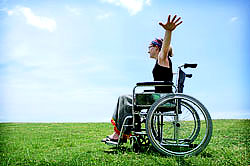|
|
Disability Culture
 Disability Culture Resources Disability Culture Resources
Movies, Books and Art - Links to film lists, books organized by disability, and art posters created by students at Lane.
Disability Culture Philosophy
Historically, disability has been viewed through the lens of a medical model. Disability has been defined in terms of a dysfunction or pathology, something that should be “cured” or “fixed” so that the individual can be as “normal” as possible. As a result, those with disabilities have often been seen in a negative light as: lacking, tragic, less-than-whole, or inferior to those who do not have a disability. The approach taken to accommodate disabilities has been to retrofit buildings and provide “special” services in order to meet legal obligations.
There’s a growing movement to shift away from a medical model and embrace a social model, which looks at disability from a different perspective. The social model sees disability as a social construct, the result of social practices and the interaction between disabled individuals and their environment. Where there are few barriers, there are few limitations. The social model looks beyond disability, acknowledging that there are individual differences, and examines all of the factors that affect an individual’s ability to interact fully as an equal participant in society.
These individual differences become part of the diversity that individuals with disabilities bring to our campus. The social model perspective challenges us to design options that provide sustainable and inclusive access for all students to fully participate in the learning environment and campus community.
Carol J. Gill, of the Chicago Institute of Disability Research, has developed the following chart to further illustrate the differences between the medical model of disability, and the new social (or sociopolitical) model:
Medical Model
-
Disability is a deficiency or abnormality
-
Being disabled is negative
-
Disability resides in the individual
-
The remedy for disability-related problems is cure or normalization of the individual
-
The agent of remedy is the professional who affects the arrangements between the individual and society
Sociopolitical Model
-
Disability is a difference
-
Being disabled, in itself, is neutral
-
Disability derives from interaction between individual and society
-
The remedy for disability-related problems is a change in the interaction between the individual and society
-
The agent of remedy can be the individual, an advocate, or anyone who affects the arrangements between the individual and society
(Adapted from University of Arizona’s Web site and other resources.)
|
 |


